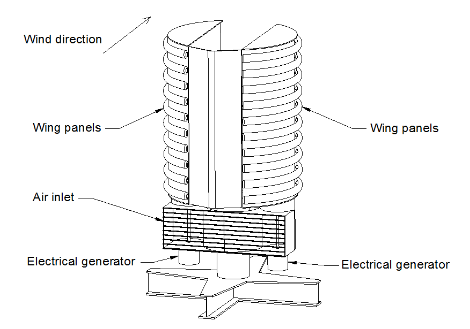A new method for conversion of wind energy into electrical energy
The new method makes it possible to harvest more wind energy as the converter is environmentally friendly and easy to install and maintain. The converter has no external rotating parts. Many components can be made from wooden materials. The converter can be adapted to both city and country areas. The converter combines the working principles of an aircraft wing and a jet engine.

Wind energy converter
When air flows along the wing panels the air pressure becomes reduced in a similar way to the reduction of air pressure that occurs on an aircraft wing. At the same time the air pressure becomes increased at the air inlet. This pressure difference causes a new air flow through the converter. The air flow passes a turbine which transfer the kinetic energy to an electrical generator. The device includes two energy converter units that works independently of each other. The units which includes wing panels, air inlet, turbines and electrical generators are pivotally mounted to a column and automatically adjust orientation to the wind direction. It is assumed that practical size of the energy converter would be a height of 3,5 m and a width of 2,0 m.
Estimated produced energy
Estimated amount of produced energy per converter with effective height 2,5 m and width 2,0 m:
in gentle breeze (3,4 – 5,4 m/s): 0,1 – 0, 39 kW
in moderate breeze (5,5 – 7,9 m/s): 0,4 – 1,19 kW
in fresh breeze (8,0 – 10,7 m/s): 1,2 – 2,9 kW
in strong breeze (10,8 – 13,8 m/s) 3,0 – 6,3 kW
in high wind (13,9 – 17,1 m/s) 6,4 – 12,1 kW
in fresh gale (17,2 – 20,7 m/s) 12,2 – 21,5 kW
As an example, in fresh breeze (8,0 – 10,7 m/s) one energy converter can generate electrical power for 31 – 74 number of 40W light bulbs.
Manufacturing
The column and foundation may be made from galvanized steel. The wing panel is a lightweight structure similar to an aircraft wing. Many of the components in the wing panel can be made from wooden materials. The wooden materials can be protected by an environmentally friendly preservative to enable easy disposal after component life time. Plastic or aluminium would be suitable materials for some components.

Wind power plant
The illustration above shows a power plant consisting of 5 no of energy converters where each converter has a height of 3,5 m and a width of 2,0 m. The energy converters are supported on concrete blocks which by own weight or by bolting to rock obtain required stability.
Estimated amount of produced energy from the power plant:
in fresh breeze (8 – 10,7 m/s): 6,0 – 14,5 kW
in strong breeze (10,8 – 13,8 m/s) 15,0 – 31,5 kW
in high wind (13,9 – 17,1 m/s) 32,0 – 60,5 kW
in fresh gale (17,2 – 20,7 m/s) 61,0 – 107,5 kW
As an example, in fresh breeze (8,0 – 10,7 m/s) the abovementioned power plant can cover 25% of the electricity consumption of 8 – 19 households (based on an average consumption of 3 kW pr household).